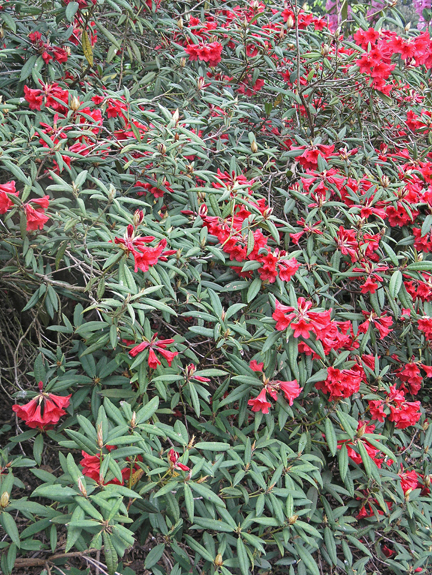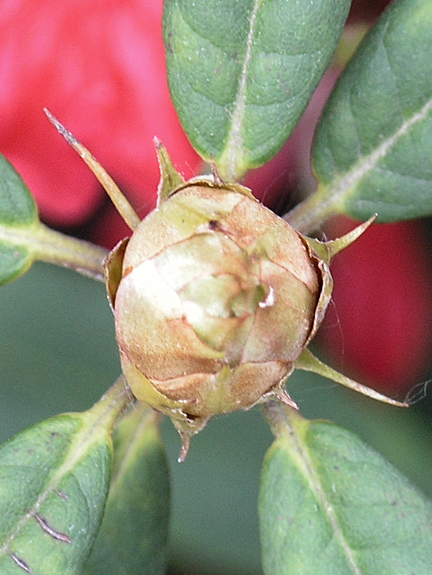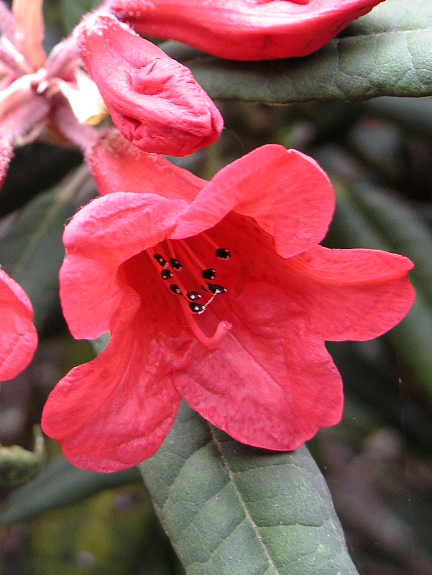| General Description | A Striking evergreen shrub with bristly woolly shoots. Elliptic or oblong lanceolate leaves, matte, olive green, 10-20 cm long leaves. Flowering with trusses of 5-12 tubular bell shaped rose-crimson, scarlet flowers. |
| ID Characteristic | Elliptic to oblong-lance-shaped matte, olive green leaves. Trusses of 5-12 tubular bell shaped rose-crimson, scarlet blooms. |
| Shape | Loose open shrub (informal). |
| Landscape | Botanical gardens, landscapes and estates where soil pH is maintained on an annual basis. R. griersonianum is not salt tolerant and its well being is heavily weighted on a acidic soil environment. R. griersonianum is more suited to large gardens where its full form can be appreciated. It lends itself to hedges, screens, shade and woodland gardens. |
| Propagation | Seed sown when ripe in the autumn is the best choice, sow in greenhouse and grow on for at least a year before setting out. Rhododendron griersonianum seeds will usually germinate in 50-90 days, but even under good conditions germination may be erratic. Sow seeds on the surface of a acid peat seed sowing mix at about 15°C. Rhododendron griersonianum seeds in the garden will mostly germinate as the weather warms up in the spring but several may germinate during the summer or autumn however most are more likely to stay dormant until the following spring.
Keep seedlings shaded from the direct sun.
Note: Recent experiments at Kew's Millenium Seed Bank by Dr. Fiona Hay have demonstrated that seed priming of R. griersonianum does improve germination rates. For further details of this experiment copy the following link into your browser minus the brackets: (https://www.seedtest.org/upload/cms/user/ISTA-June18-1600-SympSession5-P6-Hay.pdf)
Layers set down in July may take anywhere from 16-24 months to root. Cuttings rooted on a bench with bottom heat and mist in August may produce limited success.
|
| Cultivation | Establishing ideal growing conditions is crucial to the success of this species. Many of the problems likely to affect them in the home garden can be minimized by maintaining soil quality and proper ventilation. All species prefer soils with a pH of 4.5- 5.5 with a cool root environment and a freely draining, humus rich soil. The plant can withstand temperatures down to -15°C.
The root area should be mulched and kept free of other plants including ground covers since the shallow root system should not be disturbed. |
| Pests | Powdery mildew may be a problem in areas of poor air circulation. |
| Notable Specimens | Arley Hall and Gardens, Northwich, Cheshire, England |
| Habitat | Found in mixed forests and thickets at elevations of 1600–2700 m in China (west Yunnan province) and north east Myanmar (Burma).
|
| Bark/Stem Description | The bark is rough from which originate straight branches that are about 4 mm in diameter held below the inflorescence. Young shoots are glandular-setulose and woolly-tomentose and are often a drab olive green in colour. |
| Flower/Leaf Bud Description | Deep red buds with long tapering scales, 3-5 cm. |
| Leaf Description | The petiole is purple in colour, glandular-setulose, tomentose and 10–25 mm in length. The leaf blade, like many Rhododedron species is leathery and narrowly elliptic to lanceolate. Leaves are approximately 7.5–14 x 2–3.5 cm in size with an obtuse base and a revolute margin: leaf apices are acute or acuminate. The abaxial leaf surface is densely whitish or pale brown and woolly-tomentose with a glandular, tomentose mid-rib. The adaxial surface is dull green, glabrous or glabrescent at maturity with the midrib being glandular-setose towards base. The midrib is raised abaxially and grooved adaxially. Leaves have 12-18 pairs of lateral veins. |
| Flower Description | The inflorescence contains 5–12-flowers with the rachis being 10–30 mm long and densely tomentose and glandular-setulose. The pedicel is 1.5–3 cm in length and is also tomentose and glandular-setulose. The calyx is 2–3 mm in length, tomentose and glandular. The corolla is tubular and funnelform or funnel-campanulate and is deep rose-crimson to scarlet in colour and about 5–7 cm in length. The inner surface of the corolla is puberulent while the outer surface is densely hairy. The corolla is 5 lobed with 10 stamens. The corolla is 2.8–3.5 cm in size with the filaments puberulent in the lower two-thirds. The ovary is conoid, ca. 6 mm and densely dendroid-hairy and glandular; the style is also glandular at base. |
| Fruit Description | The fruit is a cylindrical capsule that is persistently tomentose and is ca. 23 x 8–9 mm. |
| Colour Description | Matte, olive green leaves with rose-crimson, scarlet flowers. |
| Texture Description | Smooth leaves with heavy hair on the underside. Coarse to the touch. Overall even when in flower the plant has a medium to coarse texture. |


